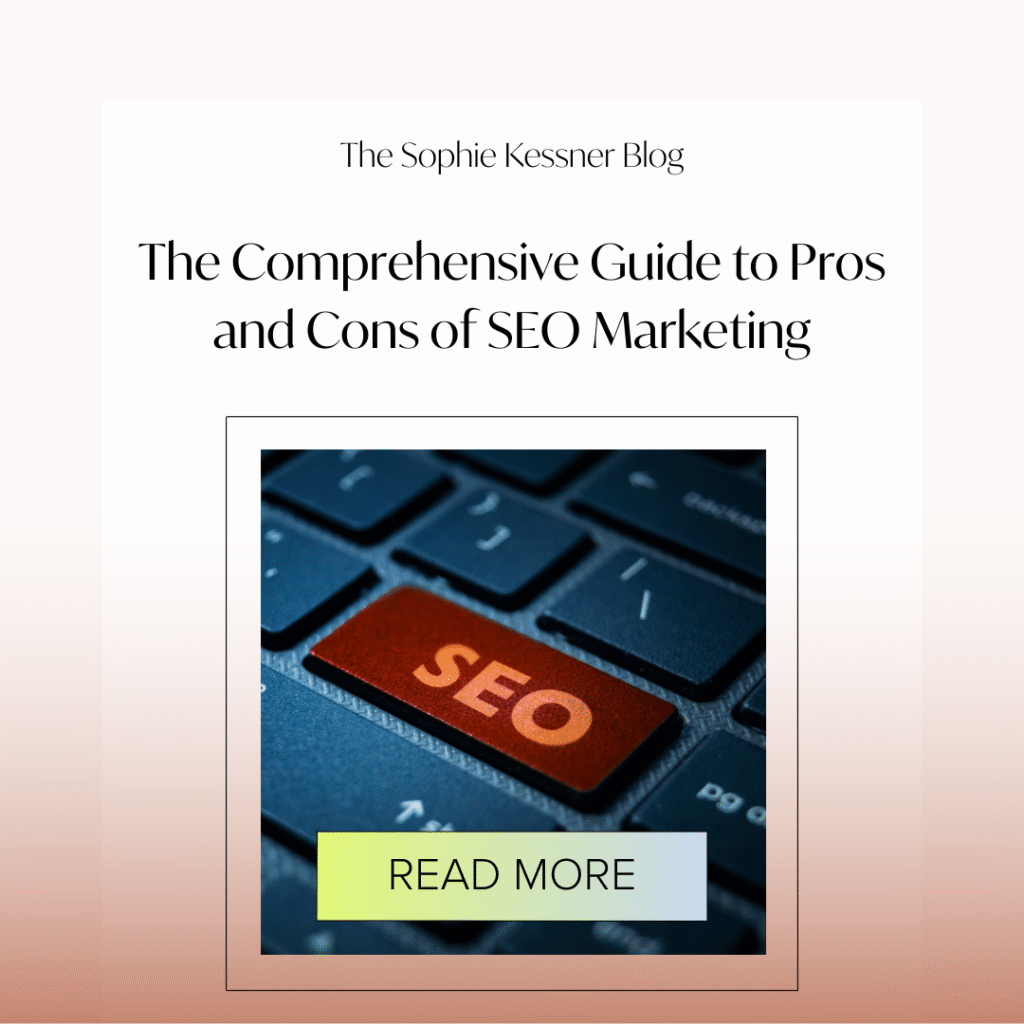Think of your website as a shop on a busy street. Without good directions, people walk right past. That’s where SEO marketing steps in. By tuning your site for search engines, you boost organic traffic, improve search rankings, and connect with people already looking for what you offer. Organic search drives 53% of all website traffic, making it one of the most powerful channels available.
But SEO isn’t all smooth sailing. It can take time to see results, and Google’s rules keep changing. In this guide, you’ll find straightforward tips on what makes SEO a smart move—like free clicks over time, better brand trust, and local search wins—and what to watch out for, from the wait to climb the rankings to the costs of tools and experts. Ready to see if SEO fits your plan?
What SEO Marketing Means
Search engine optimization, or SEO, is all about tuning your website so search engines can find it and rank it higher. It covers on‑page optimization—like updating your titles, headers and content—and off‑page work, such as earning links from other sites. SEO focuses on unpaid, natural results. Finding the right search terms—through basic keyword research—helps you match your site to real searches and boost website visibility. When you use those keywords well, your page shows up when someone types that word or phrase into Google. The goal is to guide people directly to your site when they’re already looking for what you offer.
Why SEO Matters Today
SEO sits at the heart of any digital marketing plan. It:
Drives a large share of web traffic without ongoing ad spend
Improves visibility in organic search engine results, which are crucial for long-term traffic and credibility
Works hand in hand with content marketing, social media and paid ads to boost reach
Earns more clicks than paid ads, since many users trust organic listings first
Over half of all website visits start with a search engine. By weaving SEO into other channels, you create a marketing mix that catches customers at every step, from their first search to their final click.
How Search Engine Algorithms Work
Search engine algorithms are complex systems used by search engines to rank websites in search engine results pages (SERPs). These algorithms take into account various factors, including keyword research, technical SEO, and link building, to determine the relevance and quality of a website. Google’s algorithm, in particular, is constantly evolving, with updates aimed at improving the user experience and providing more accurate search results. Understanding how search engine algorithms work is essential for developing an effective SEO strategy that drives organic traffic and improves website visibility.
How SEO Has Changed Over Time
SEO has come a long way. Years ago, stuffing pages with the same keywords could lift your rank. Then came updates like Panda, Penguin and the move to mobile‑first indexing, which weeded out low‑quality sites. Now, search engines reward fast, mobile‑friendly sites that answer user questions clearly. Even as the rules shift, and Google’s algorithm frequently updates, sites that focus on helpful content and easy navigation tend to rise to the top.
Creating a Marketing Strategy
A well-planned marketing strategy is vital for business growth, and SEO plays a significant role in it. By incorporating SEO into a digital marketing strategy, businesses can increase their online presence, drive more targeted traffic, and generate leads.
A comprehensive marketing strategy should include a combination of SEO, social media marketing, email marketing, and paid advertising to reach a wider audience. Conducting keyword research and analyzing search intent can help businesses identify their target audience and create content that resonates with them. With the help of Google Analytics, businesses can track their website traffic, click-through rates, and conversion rates to measure the effectiveness of their SEO efforts.
The Powerful Advantages of SEO Marketing

Driving Sustainable and High-Quality Organic Traffic
Climbing to the top of organic search results brings you more eyes on your site. When you hit the first page for key terms, you attract people already looking for what you offer. That means more clicks and better chances to turn visits into sales. Unlike paid ads that disappear when you stop paying, organic traffic sticks around. Here’s why it matters:
You pull in visitors who are ready to buy or learn.
You see steady traffic even during slow seasons.
High click-through rates mean more leads for less cost.
A clear focus on keyword research and on-page SEO boosts your rankings over time.
With a strong SEO plan, your site becomes a magnet for quality traffic, cutting the cost per lead and lifting your bottom line. Over time, those initial wins compound. As your site gains authority, you rank for more terms without extra work. That steady stream of visitors gives you room to try new pages or offers without worrying about big drops. That long‑term flow helps you plan ahead instead of scrambling for quick wins.
Building Trust and Credibility
Showing up on page one does more than bring clicks. It signals you know your stuff and users trust organic results more than ads. Every time someone sees your site near the top, it boosts your brand’s credibility and strengthens your web presence. To build that trust, you need quality content, a clear site layout, and real proof. You can:
Share case studies or client stories that show real wins
Follow Google’s E‑E‑A‑T ideas: highlight your experience, expertise, authoritativeness, and trustworthiness
Use clear, honest meta descriptions so people know what to expect
Secure your site with HTTPS and optimize for mobile screens
A well‑organized menu and easy‑to‑read pages keep visitors around longer. When people spend more time on your site, search engines see you as valuable. That helps your site climb even higher. Over time, that credibility turns first‑time visitors into loyal fans. Testimonials and reviews from happy clients also boost your standing. A few genuine quotes can make a big difference.
Cost‑Effective Marketing with Long‑Term ROI
Unlike ads that stop bringing traffic once you pause your budget, SEO keeps working. For every dollar spent on SEO, businesses earn an average of over $22. The main cost is time and effort—you either dive in yourself or pay someone to help. After the initial setup, organic traffic comes for free. That lowers your cost per lead over time. Here’s how:
You build an asset that pays off month after month.
You learn what works and spend less on what doesn’t.
Every optimized page adds value to your site’s authority.
Additionally, the SEO benefits include significantly improving your website’s visibility in search engine results, leading to better rankings for desired keywords.
You can re‑use SEO data to guide paid campaigns and content ideas. That cuts costs across your whole marketing mix. In short, SEO delivers steady growth without a constant ad bill. Once you hit your stride, those free clicks often bring a higher return than most paid channels.
Measurable Results and Data‑Driven Optimization
With an effective SEO campaign, you know what’s working. Tools like Google Analytics and Search Console give clear data: how many people visit, which keywords they use, and where they land. That means you can:
Track organic traffic, bounce rate, and conversion rate
Spot pages that need a refresh or new keywords to target
Compare your site’s performance against competitors
You can even set up goals to see which keywords bring the best leads. By checking those numbers regularly, you tweak your pages or add fresh content exactly when it’s needed. That data‑driven approach keeps your site climbing and helps you avoid wasting time on tactics that don’t move the needle.
Enhancing User Experience for Better Engagement and Conversions
Search engines want happy users, so they reward sites that are fast, easy to use and mobile‑friendly across devices. Improving your site’s design isn’t just for looks—it helps you rank higher and keeps people around longer. Focus on:
Speed: cut page load times by compressing images and using caching
Clear menus: help users find what they need in one or two clicks
Readable layout: use short paragraphs, headings and bullet points
Don’t forget to test regularly on mobile devices. What works on a desktop may feel clunky on a phone. When your site feels smooth, visitors stick around. Longer visits and lower bounce rates send positive signals to search engines and lift your rankings. Plus, happier users are more likely to fill out forms or buy your products.
Unlocking the Power of Local SEO
If you serve a specific area, local SEO puts you in front of nearby customers. By claiming and updating your Google Business Profile, you show up in map and local search results. Don’t skip these steps:
Use your city or region in your site’s titles and meta descriptions
Collect real reviews from local clients and reply to them
Add clear NAP info (name, address, phone) on every page
Local SEO can be a game‑changer for small businesses with limited budgets. Those local touches boost your odds of showing up when someone searches for “therapist near me” or “SEO help in [City].” Local traffic often leads to quick calls or visits. Utilizing a combined SEO and PPC approach can further enhance your visibility and performance across different geographic areas.
Boosting Brand Awareness and Industry Authority
When your site ranks for multiple keywords relevant to your industry, more people see your name. That builds brand recall—customers know you before they click. High‑quality blog posts and guides position you as a go‑to expert. Over time, those mentions and links from other sites boost your site’s authority. You’ll:
Show up for branded searches when people look for your name
Earn links from other blogs or news sites that reference your work
Grow your network as peers and prospects take notice
That kind of authority makes it easier to launch new services or content. Every share or mention online adds to that effect.
Versatility for Different Needs
SEO isn’t one‑size‑fits‑all. You can target readers with blog posts, buyers with product pages, or locals with service pages. Videos, infographics and how‑to guides boost your reach. This flexible mix helps you tap many search queries and reach people at every stage of their journey. Integrating both SEO and PPC as part of a comprehensive search marketing strategy can further enhance your overall results.
Understanding the Challenges and Disadvantages of SEO Marketing

The Time Investment and Gradual Nature of Results
SEO isn’t a quick fix, and it often takes months to see big changes in your search engine rankings. You’ll spend time researching keywords, tweaking pages, building links, and waiting for search engines to notice. Factors like your site’s age, the competition, and the quality of your work all affect how fast you climb the rankings. That delay can be tough if you need immediate leads or sales. You might start feeling stuck, hoping for a traffic boost that takes longer than planned.
But that wait pays off in the long run. When you stick to a solid SEO plan, your site gains trust and authority. You’ll see steady improvements instead of spikes and drops. Patience gives you reliable results and a steady flow of visitors over time. Think of SEO as planting seeds—you water them now and reap the benefits later.
It also means regular check‑ins on your progress: monthly keyword reports, quarterly content audits and ongoing link outreach. Over time, you’ll learn what tactics pay off and avoid wasting effort on tactics that don’t work. That steady push builds momentum and helps you plan with confidence.
Navigating the Highly Competitive Online Landscape
Some niches are packed with well‑established players. Big brands often have bigger budgets, more content, and stronger link profiles. That makes it hard for smaller sites to stand out for popular keywords. Even less competitive, long‑tail terms need steady effort and strategy.
To compete, you can:
Focus on niche topics or local phrases
Create content that answers very specific questions
Partner with complementary sites to earn links
Keep refining based on performance data
By carving out a smaller slice of the market, you can build authority in areas where big brands don’t focus.
The Constant Evolution of Search Engine Algorithms
Search engines update their rules regularly, impacting both SEO and search engine marketing strategies. Major updates like Google’s core changes, Core Web Vitals or mobile‑first indexing can shake up rankings overnight.
These updates aim to give searchers better results but can catch you off guard if you’re not ready. Sites that ignored quality or mobile users in the past have lost ground. Even well‑optimized sites can see ranking dips after an algorithm tweak.
Staying on top of these changes means:
Following credible SEO blogs and forums
Testing new tactics on low‑risk pages before a full rollout
Keeping a backup of your site and a recovery plan
Reviewing Core Web Vitals and user metrics to meet new performance benchmarks
By watching for early announcements and monitoring your traffic, you’ll spot issues fast and adjust to keep your ranks steady.
The Absence of Guaranteed Rankings
No one can promise you’ll hit the top spot for your targeted keywords, no matter how much you invest. Search engines use hundreds of factors, many of which are out of your control—like user behavior or competitor moves. Ethical SEO pros avoid ranking guarantees because they can’t control every signal.
Instead of chasing a #1 spot, focus on:
Improving click‑through rates from your current positions
Growing traffic from related keywords
Enhancing user engagement on your pages
That way, you’ll get more value from your efforts even if you’re not at the very top.
Potential Costs and Resource Allocation
Effective SEO needs time, money, and sometimes paid search. You might hire an agency, buy SEO tools, or dedicate in‑house hours. DIY SEO is cheaper but demands research and hands‑on work. Subscriptions for keyword tools, link checkers, or analytics can add up.
To manage costs:
Set a clear budget for tools and services
Track ROI to see which tactics pay off
Outsource only when you need extra help Being smart about resource use helps you avoid overspending on tactics that don’t move the needle.
The Difficulty of Cracking High‑Value, Competitive Keywords
Targeting broad, high‑volume keywords often feels like climbing a steep hill. Big sites with strong link profiles dominate these terms. Even if you rank in the top ten, you might slip down when a competitor publishes fresh content. Unlike paid search traffic, which provides immediate results but stops once the budget runs out, SEO offers long-term benefits.
Try a mixed approach:
Blend head terms with long‑tail phrases
Focus on lower‑volume keywords with clear intent
Update existing content to keep it relevant That way, you capture traffic from many angles instead of betting everything on a single keyword.
The Risks Associated with Unethical SEO Tactics
Unethical shortcuts can backfire. Black hat tactics—like keyword stuffing, link farms or cloaking—might work briefly but often draw penalties. Google can demote or even remove sites that break rules, negatively impacting your unpaid search results.
Stay safe by:
Following Google’s guidelines
Auditing your backlink profile regularly
Using trusted outreach methods for link building
Playing fair keeps your site in good standing and avoids long recovery times.
The Need for Continuous Monitoring and Maintenance
SEO isn’t set‑and‑forget. You’ll need to:
Refresh SEO content to match new search trends
Fix broken links or technical issues
Check site speed and mobile performance
Plan monthly audits and run quarterly content reviews to catch small issues before they grow. That way, you keep your site running smoothly and avoid surprises that hurt your rankings. Ongoing care keeps your site healthy and competitive.
SEO vs PPC Advertising
Search engine optimization (SEO) and pay‑per‑click both aim to boost your site’s visibility, but they work differently. SEO delivers long‑term organic growth, while PPC drives quick traffic through paid placement. When you use them together:
Test keywords with PPC ads to see which terms convert best, then focus SEO on top performers
Use SEO data to refine ad copy and landing pages
Balance budget: scale PPC for time‑sensitive offers and lean on SEO for steady traffic
How SEO and Content Work Together
Content and SEO are a team, and well-developed SEO strategies are crucial. You need helpful articles, guides and pages to give search engines reasons to rank you. In turn, SEO points readers to your content.
Pick topics based on keyword research and audience questions
Add internal links to guide readers between pages
Update older content to include fresh data and trends
The Role of Social Media

Organic marketing through social media may not directly affect rankings, but it supports SEO. By sharing links and engaging your audience, you drive referral traffic and brand mentions. A strong social presence helps your content reach new readers and earn natural backlinks.
Best Strategy for Business Growth
The best strategy for business growth involves a combination of SEO and paid advertising. While SEO provides long-term benefits and drives organic traffic, paid advertising, such as Google Ads, can provide immediate results and increase website visibility.
By targeting competitive keywords and creating high-quality content, businesses can improve their search rankings and drive more targeted traffic to their site. Local SEO is also essential for small businesses and local businesses, as it helps them reach their target audience and increase their online presence.
With the help of influencer marketing and content marketing, businesses can create engaging content that resonates with their audience and drives more traffic to their site. Ultimately, a well-planned SEO strategy and a comprehensive digital marketing strategy can help businesses achieve their goals and drive business growth.
Wrapping Up Your SEO Takeaway
You’ve seen how SEO can bring steady, high‑quality traffic, boost trust in your brand, and deliver lasting value without a constant ad bill. You’ve also read about the wait it takes, the competition, and why you can’t promise a #1 spot. Understanding the pros and cons of SEO marketing helps set realistic expectations. The best path forward combines patience with data‑driven tweaks, local focus if you serve nearby clients, and ethical practices that keep you in good standing with Google.
Start small—pick a handful of keywords, optimize a few pages, track the results—and build from there. When people search for specific services or answers, businesses must strive to appear among the top results for those queries.
Ready to dive deeper? Enroll in Sass and SEO’s DIY SEO course for step‑by‑step guidance, or partner with our agency for expert‑led strategy and support.
Frequently Asked Questions (FAQs)
1. What is SEO marketing?
SEO marketing involves optimizing your website to rank higher on search engines like Google. It helps drive organic traffic by making your site more visible to users searching for relevant keywords.
2. How long does it take to see results from SEO?
SEO is a long-term strategy, and it can take several months to see significant results in search engine results pages (SERPs). The timeline depends on factors like competition, website quality, and the keywords you’re targeting.
3. Is SEO better than paid advertising?
SEO offers long-term benefits with lower ongoing costs compared to paid ads. While paid ads bring quick traffic, SEO delivers organic visibility that lasts longer without continuous spending.
4. Can I do SEO on my own?
Yes, you can learn and apply SEO techniques on your own with the right tools and resources. However, for more advanced strategies, working with an expert or agency can help you achieve faster results.
5. What are black hat SEO tactics?
Black hat SEO tactics involve unethical methods like keyword stuffing or link farming to manipulate search rankings. These practices can lead to penalties or even being removed from search engine results entirely.





